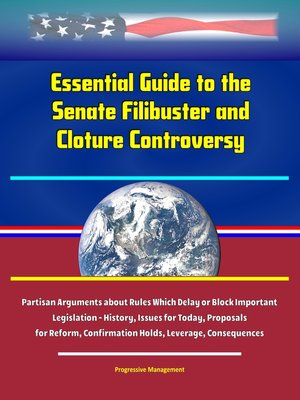Essential Guide to the Senate Filibuster and Cloture Controversy
ebook ∣ Partisan Arguments about Rules Which Delay or Block Important Legislation--History, Issues for Today, Proposals for Reform, Confirmation Holds, Leverage, Consequences
By Progressive Management

Sign up to save your library
With an OverDrive account, you can save your favorite libraries for at-a-glance information about availability. Find out more about OverDrive accounts.
Find this title in Libby, the library reading app by OverDrive.



Search for a digital library with this title
Title found at these libraries:
| Library Name | Distance |
|---|---|
| Loading... |
Professionally converted for accurate flowing-text e-book format reproduction, this unique book reproduces important documents, reports, and studies dealing with the controversial issue of Senate filibusters and the cloture rule. Using the filibuster to delay or block legislative action has a long history. The term filibuster—from a Dutch word meaning "pirate"—became popular in the 1850s, when it was applied to efforts to hold the Senate floor in order to prevent a vote on a bill.
Contents: Filibuster and Cloture * Filibusters and Cloture in the Senate Report * Examining the Filibuster * Hearings Before the Committee on Rules and Administration * DAY 1) April 22, 2010 - Examining The Filibuster * DAY 2) May 19, 2010 - Examining The Filibuster: The Filibuster Today And Its Consequences * DAY3) June 23, 2010 - Examining The Filibuster: Silent Filibusters, Holds And The Senate Confirmation Process * DAY 4) July 28, 2010 - Examining The Filibuster: Legislative Proposals To Change Senate Procedures * DAY 5) September 22, 2010 - Examining The Filibuster: Legislative Proposals To Change Senate Procedures * DAY 6) September 29, 2010 - Examining The Filibuster: Ideas To Reduce Delay And Encourage Debate In The Senate * Senate Cloture Rule Report * Part 1 - Limitation of Debate in the Senate of the United States * Part 2 - Legislative History of Paragraph 2 of Rule XXII of the Standing Rules of the United States Senate (Cloture Rule) * Changing the Senate Cloture Rule at the Start of a New Congress - Some topics covered in the reports: The Right to Debate * The Right to Recognition * The Right to Speak at Length and the Two-Speech Rule * The Motion to Table * The Conduct of Filibusters * Germaneness of Debate * Yielding the Floor and Yielding for Questions * Quorums and Quorum Calls * Roll Call Voting * Scheduling Filibusters * Invoking Cloture * Matters on Which Cloture May Be Invoked * Timing of Cloture Motions * Effects of Invoking Cloture * Time for Consideration and Debate * Offering Amendments and Motions * Germane Amendments Only * Amendments Submitted in Advance * Multiple Amendments * Dilatory Amendments and Motions * Reading and Division of Amendments * The Authority of the Presiding Officer * Business on the Senate Floor * The Impact of Filibusters * Impact on the Time for Consideration * The Prospect of a Filibuster * Holds * Linkage and Leverage * Consensus
The ability of Senators to engage in filibusters has a profound and pervasive effect on how the Senate conducts its business on the floor. In the face of a threatened filibuster, for example, the majority leader may decide not to call a bill up for floor consideration or may defer calling it up if there are other, equally important bills the Senate can consider and pass with less delay. Similarly, the prospect of a filibuster can persuade a bill's proponents to accept changes in the bill that they do not support but that are necessary to prevent an actual filibuster.
Reform-minded Senators have generally viewed the opening of a new Congress as a special constitutional time that permits the Senate to amend its procedures by majority vote unencumbered by chamber rules adopted by a previous Congress. They cite the U.S. Constitution (Article I, Section 5) as their authority: "Each House may determine the Rules of its Proceedings," which implicitly means by majority vote, state the reformers. Opponents reject this assertion and point out that the Senate has adopted rules, and the Constitution says nothing about the vote required to adopt those rules. Moreover, the Senate is a continuing body with continuing rules.







